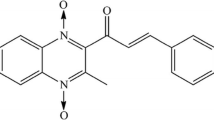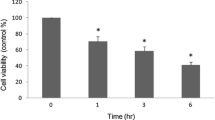Abstract
SET protein (I2PP2A) is an inhibitor of PP2A, which regulates the phosphorylated Akt (protein kinase B) levels. We assessed the effects of SET overexpression in HEK293T cells, both in the presence and the absence of mild oxidative stress induced by 50 μM tert-butyl hydroperoxide. Immunoblotting assays demonstrated that SET accumulated in HEK293T cells and increased the levels of phosphorylated Akt and PTEN; in addition, SET decreased glutathione antioxidant defense of cell and increased expression of genes encoding antioxidant defense proteins. Immunofluorescence analysis demonstrated that accumulated SET was equally distributed in cytoplasm and nucleus; however, in cells that had been exposed to oxidative stress, SET was found in large aggregates in the cytoplasm. SET accumulation in HEK293T cells correlated with inhibition of basal apoptosis as evidenced by a decrease in annexin V staining and activity of caspases; under mild oxidative stress, SET accumulation correlated with caspase-independent cell death, as evidenced by increased PI and annexin V/PI double staining. The results suggest that accumulated SET could act via Akt/PTEN either as cell survival signal or as oxidative stress sensor for cell death.





Similar content being viewed by others
Explore related subjects
Discover the latest articles and news from researchers in related subjects, suggested using machine learning.References
Franke TF, Kaplan DR, Cantley LC (1997) PI3K: downstream AKTion blocks apoptosis. Cell 88(4):435–437. doi:10.1016/S0092-8674(00)81883-8
Stambolic V, Suzuki A, de la Pompa JL, Brothers GM, Mirtsos C, Sasaki T, Ruland J, Penninger JM, Siderovski DP, Mak TW (1998) Negative regulation of PKB/Akt-dependent cell survival by the tumor suppressor PTEN. Cell 95(1):29–39. doi:10.1016/S0092-8674(00)81780-8
Kuo YC, Huang KY, Yang CH, Yang YS, Lee WY, Chiang CW (2008) Regulation of phosphorylation of Thr-308 of Akt, cell proliferation, and survival by the B55alpha regulatory subunit targeting of the protein phosphatase 2A holoenzyme to Akt. J Biol Chem 283(4):1882–1892. doi:10.1074/jbc.M709585200
Li M, Damuni Z (1998) I1PP2A and I2PP2A. Two potent protein phosphatase 2A-specific inhibitor proteins. Methods Mol Biol 93:59–66
ten Klooster JP, Leeuwen I, Scheres N, Anthony EC, Hordijk PL (2007) Rac1-induced cell migration requires membrane recruitment of the nuclear oncogene SET. EMBO J 26(2):336–345. doi:10.1038/sj.emboj.7601518
Canela N, Rodriguez-Vilarrupla A, Estanyol JM, Diaz C, Pujol MJ, Agell N, Bachs O (2003) The SET protein regulates G2/M transition by modulating cyclin B-cyclin-dependent kinase 1 activity. J Biol Chem 278(2):1158–1164. doi:10.1074/jbc.M207497200
Fukukawa C, Shima H, Tanuma N, Okada T, Kato N, Adachi Y, Kikuchi K (2005) The oncoprotein I-2PP2A/SET negatively regulates the MEK/ERK pathway and cell proliferation. Int J Oncol 26(3):751–756
Zhao T, Zhang H, Guo Y, Zhang Q, Hua G, Lu H, Hou Q, Liu H, Fan Z (2007) Granzyme K cleaves the nucleosome assembly protein SET to induce single-stranded DNA nicks of target cells. Cell Death Differ 14(3):489–499. doi:10.1038/sj.cdd.4402040
Patel V, Hood BL, Molinolo AA, Lee NH, Conrads TP, Braisted JC, Krizman DB, Veenstra TD, Gutkind JS (2008) Proteomic analysis of laser-captured paraffin-embedded tissues: a molecular portrait of head and neck cancer progression. Clin Cancer Res 14(4):1002–1014. doi:10.1158/1078-0432.CCR-07-1497
Madeira A, Pommet JM, Prochiantz A, Allinquant B (2005) SET protein (TAF1beta, I2PP2A) is involved in neuronal apoptosis induced by an amyloid precursor protein cytoplasmic subdomain. FASEB J 19(13):1905–1907. doi:10.1096/fj.05-3839fje
Constantinou C, Papas KA, Constantinou AI (2009) Caspase-independent pathways of programmed cell death: the unraveling of new targets of cancer therapy? Curr Cancer Drug Targets 9(6):717–728
Hanahan D, Weinberg RA (2011) Hallmarks of cancer: the next generation. Cell 144(5):646–674. doi:10.1016/j.cell.2011.02.013
Pani G, Galeotti T, Chiarugi P (2010) Metastasis: cancer cell’s escape from oxidative stress. Cancer Metastasis Rev 29(2):351–378. doi:10.1007/s10555-010-9225-4
Antico Arciuch VG, Galli S, Franco MC, Lam PY, Cadenas E, Carreras MC, Poderoso JJ (2009) Akt1 intramitochondrial cycling is a crucial step in the redox modulation of cell cycle progression. PLoS One 4(10):e7523. doi:10.1371/journal.pone.0007523
Chetram MA, Don-Salu-Hewage AS, Hinton CV (2011) ROS enhances CXCR4-mediated functions through inactivation of PTEN in prostate cancer cells. Biochem Biophys Res Commun 410(2):195–200. doi:10.1016/j.bbrc.2011.05.074
Thomas P, Smart TG (2005) HEK293 cell line: a vehicle for the expression of recombinant proteins. J Pharmacol Toxicol Methods 51(3):187–200. doi:10.1016/j.vascn.2004.08.014
Castilho RM, Squarize CH, Chodosh LA, Williams BO, Gutkind JS (2009) mTOR mediates Wnt-induced epidermal stem cell exhaustion and aging. Cell Stem Cell 5(3):279–289. doi:10.1016/j.stem.2009.06.017
Yuan JS, Reed A, Chen F, Stewart CN Jr (2006) Statistical analysis of real-time PCR data. BMC Bioinformatics 7:85. doi:10.1186/1471-2105-7-85
Zhu Y, Hoell P, Ahlemeyer B, Sure U, Bertalanffy H, Krieglstein J (2007) Implication of PTEN in production of reactive oxygen species and neuronal death in in vitro models of stroke and Parkinson’s disease. Neurochem Int 50(3):507–516. doi:10.1016/j.neuint.2006.10.010
Franke TF, Kaplan DR, Cantley LC, Toker A (1997) Direct regulation of the Akt proto-oncogene product by phosphatidylinositol-3,4-bisphosphate. Science 275(5300):665–668. doi:10.1126/science.275.5300.665
Pelicano H, Carney D, Huang P (2004) ROS stress in cancer cells and therapeutic implications. Drug Resist Updat 7(2):97–110. doi:10.1016/j.drup.2004.01.004
Aliev G (2011) Oxidative stress induced-metabolic imbalance, mitochondrial failure, and cellular hypoperfusion as primary pathogenetic factors for the development of Alzheimer disease which can be used as a alternate and successful drug treatment strategy: past, present and future. CNS Neurol Disord Drug Targets 10(2):147–148
Harrison EM, Sharpe E, Bellamy CO, McNally SJ, Devey L, Garden OJ, Ross JA, Wigmore SJ (2008) Heat shock protein 90-binding agents protect renal cells from oxidative stress and reduce kidney ischemia-reperfusion injury. Am J Physiol Renal Physiol 295(2):F397–F405. doi:10.1152/ajprenal.00361.2007
Chohan MO, Khatoon S, Iqbal IG, Iqbal K (2006) Involvement of I2PP2A in the abnormal hyperphosphorylation of tau and its reversal by Memantine. FEBS Lett 580(16):3973–3979. doi:10.1016/j.febslet.2006.06.021
Carlson SG, Eng E, Kim EG, Perlman EJ, Copeland TD, Ballermann BJ (1998) Expression of SET, an inhibitor of protein phosphatase 2A, in renal development and Wilms’ tumor. J Am Soc Nephrol 9(10):1873–1880
Li M, Makkinje A, Damuni Z (1996) The myeloid leukemia-associated protein SET is a potent inhibitor of protein phosphatase 2A. J Biol Chem 271(19):11059–11062. doi:10.1074/jbc.271.19.11059
Tanimukai H, Grundke-Iqbal I, Iqbal K (2005) Up-regulation of inhibitors of protein phosphatase-2A in Alzheimer’s disease. Am J Pathol 166(6):1761–1771. doi:10.1016/S0002-9440(10)62486-8
Chen H, Zhou L, Lin CY, Beattie MC, Liu J, Zirkin BR (2010) Effect of glutathione redox state on Leydig cell susceptibility to acute oxidative stress. Mol Cell Endocrinol 323(2):147–154. doi:10.1016/j.mce.2010.02.034
Walsh B, Pearl A, Suchy S, Tartaglio J, Visco K, Phelan S (2009) Overexpression of Prdx6 and resistance to peroxide-induced death in Hepa1–6 cells: Prdx suppression increases apoptosis. Redox Rep 14(6):275–284. doi:10.1179/135100009X12525712409652
Skrzycki M, Majewska M, Podsiad M, Czeczot H (2009) Expression and activity of superoxide dismutase isoenzymes in colorectal cancer. Acta Biochim Pol 56(4):663–670
Welsh S, Bellamy W, Briehl M, Powis G (2002) The redox protein thioredoxin-1 (Trx-1) increases hypoxia-inducible factor 1alpha protein expression: Trx-1 overexpression results in increased vascular endothelial growth factor production and enhanced tumor angiogenesis. Cancer Res 62(17):5089–5095
Azzu V, Jastroch M, Divakaruni A, Brand M (2010) The regulation and turnover of mitochondrial uncoupling proteins. Biochim Biophys Acta. doi:10.1016/j.bbabio.2010.02.035
Himms-Hagen J, Harper M (2001) Physiological role of UCP3 may be export of fatty acids from mitochondria when fatty acid oxidation predominates: an hypothesis. Exp Biol Med (Maywood) 226(2):78–84
Huppertz C, Fischer B, Kim Y, Kotani K, Vidal-Puig A, Slieker L, Sloop K, Lowell B, Kahn B (2001) Uncoupling protein 3 (UCP3) stimulates glucose uptake in muscle cells through a phosphoinositide 3-kinase-dependent mechanism. J Biol Chem 276(16):12520–12529. doi:10.1074/jbc.M011708200
Kim D, Oh B, Kim Y (2009) Splicing factor ASF/SF2 and transcription factor PPAR-gamma cooperate to directly regulate transcription of uncoupling protein-3. Biochem Biophys Res Commun 378(4):877–882. doi:10.1016/j.bbrc.2008.12.009
Vazquez F, Ramaswamy S, Nakamura N, Sellers WR (2000) Phosphorylation of the PTEN tail regulates protein stability and function. Mol Cell Biol 20(14):5010–5018
Myers MP, Pass I, Batty IH, Van der Kaay J, Stolarov JP, Hemmings BA, Wigler MH, Downes CP, Tonks NK (1998) The lipid phosphatase activity of PTEN is critical for its tumor supressor function. Proc Natl Acad Sci USA 95(23):13513–13518. doi:10.1073/pnas.95.23.13513
Song MS, Carracedo A, Salmena L, Song SJ, Egia A, Malumbres M, Pandolfi PP (2011) Nuclear PTEN regulates the APC-CDH1 tumor-suppressive complex in a phosphatase-independent manner. Cell 144(2):187–199. doi:10.1016/j.cell.2010.12.020
Choi YC, Lee JH, Hong KW, Lee KS (2004) 17 Beta-estradiol prevents focal cerebral ischemic damages via activation of Akt and CREB in association with reduced PTEN phosphorylation in rats. Fundam Clin Pharmacol 18(5):547–557. doi:10.1111/j.1472-8206.2004.00284.x
Vermes I, Haanen C, Steffens-Nakken H, Reutelingsperger C (1995) A novel assay for apoptosis. Flow cytometric detection of phosphatidylserine expression on early apoptotic cells using fluorescein labelled Annexin V. J Immunol Methods 184(1):39–51. doi:10.1016/0022-1759(95)00072-I
Bröker LE, Kruyt FA, Giaccone G (2005) Cell death independent of caspases: a review. Clin Cancer Res 11(9):3155–3162. doi:10.1158/1078-0432.CCR-04-2223
Cardone MH, Roy N, Stennicke HR, Salvesen GS, Franke TF, Stanbridge E, Frisch S, Reed JC (1998) Regulation of cell death protease caspase-9 by phosphorylation. Science 282(5392):1318–1321. doi:10.1126/science.282.5392.1318
Gao Y, Ordas R, Klein JD, Price SR (2008) Regulation of caspase-3 activity by insulin in skeletal muscle cells involves both PI3-kinase and MEK-1/2. J Appl Physiol 105(6):1772–1778. doi:10.1152/japplphysiol.90636.2008
Liu GP, Wei W, Zhou X, Zhang Y, Shi HH, Yin J, Yao XQ, Peng CX, Hu J, Wang Q, Li HL, Wang JZ (2010) I(2)(PP2A) regulates p53 and Akt correlatively and leads the neurons to abort apoptosis. Neurobiol Aging. doi:10.1016/j.neurobiolaging.2010.01.016
Bononi A, Agnoletto C, De Marchi E, Marchi S, Patergnani S, Bonora M, Giorgi C, Missiroli S, Poletti F, Rimessi A, Pinton P (2011) Protein kinases and phosphatases in the control of cell fate. Enzyme Res 2011:329098. doi:10.4061/2011/329098
Fan C, He L, Kapoor A, Rybak AP, De Melo J, Cutz JC, Tang D (2009) PTEN inhibits BMI1 function independently of its phosphatase activity. Mol Cancer 8:98. doi:10.1186/1476-4598-8-98
Shen WH, Balajee AS, Wang J, Wu H, Eng C, Pandolfi PP, Yin Y (2007) Essential role for nuclear PTEN in maintaining chromosomal integrity. Cell 128(1):157–170. doi:10.1016/j.cell.2006.11.042
Robey RB, Hay N (2009) Is Akt the “Warburg kinase”?−Akt-energy metabolism interactions and oncogenesis. Semin Cancer Biol 19(1):25–31. doi:10.1016/j.semcancer.2008.11.010
Chung SH (2009) Aberrant phosphorylation in the pathogenesis of Alzheimer’s disease. BMB Rep 42(8):467–474
Ming M, Feng L, Shea CR, Soltani K, Zhao B, Han W, Smart RC, Trempus CS, He YY (2011) PTEN positively regulates UVB-induced DNA damage repair. Cancer Res 71(15):5287–5295. doi:10.1158/0008-5472.CAN-10-4614
Kodera Y, Isobe K, Yamauchi M, Kondoh K, Kimura N, Akiyama S, Itoh K, Nakashima I, Takagi H (1994) Expression of nm23 H-1 RNA levels in human gastric cancer tissues. A negative correlation with nodal metastasis. Cancer 73(2):259–265. doi:10.1007/BF00309953
Acknowledgments
Research supported by FAPESP (Fellowship 2005/03380-2, Young research project 2006/06334-4, Grant 2009/52228-0), CNPq, CAPES and the Intramural Research Program of NIH, National Institute of Dental and Craniofacial Research. The authors thank Fabiana R. Morais for technical support with the FACS analysis.
Author information
Authors and Affiliations
Corresponding author
Electronic supplementary material
Below is the link to the electronic supplementary material.
Rights and permissions
About this article
Cite this article
Leopoldino, A.M., Squarize, C.H., Garcia, C.B. et al. Accumulation of the SET protein in HEK293T cells and mild oxidative stress: cell survival or death signaling. Mol Cell Biochem 363, 65–74 (2012). https://doi.org/10.1007/s11010-011-1158-x
Received:
Accepted:
Published:
Issue Date:
DOI: https://doi.org/10.1007/s11010-011-1158-x
Keywords
Profiles
- J. Silvio Gutkind View author profile




